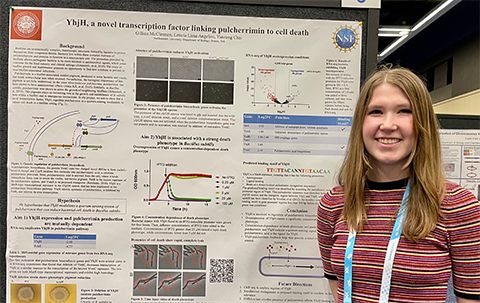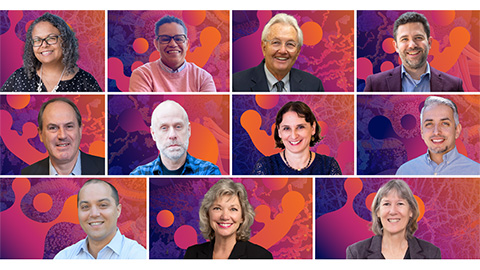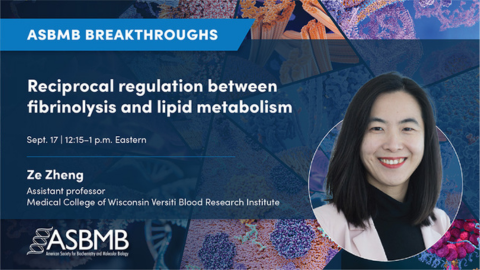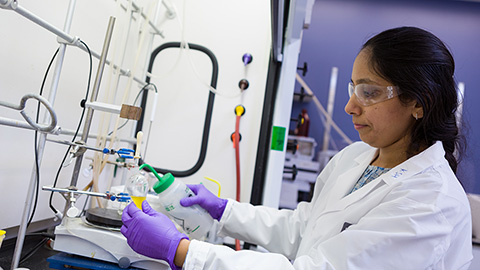
How to make a great poster
What are the elements that make a scientific research poster stand out from the crowd? To find out, we went to the experts. We asked longtime judges of the ASBMB’s Undergraduate Poster Competition to share their tips and tricks. Here, six of them offer their wisdom:
Before beginning work on your poster, think about the one or two take-home messages you want your viewer to understand from viewing your poster. People often want to put everything they did for the project on the poster, but this ends up obscuring the main message. Less is more.

—Kristin Fox, Union College
Focus on using high-quality and descriptive figures or schematics to tell as much of the story as possible, using words sparingly or only as necessary. Pictures or figures are generally far more efficient and effective at conveying information than text. They also stand a greater chance of capturing the attention of an attendee.
—Craig Streu, Albion College
Use good design principles: simple designs, not necessarily what PowerPoint suggests, simple legible fonts and contrasting backgrounds. Make sure you use only a couple of different sizes of font (one for titles and one for text, for example) and make sure things are in alignment. I can't stand it when posters have figures that are crooked or not lined up with one another.
—John Tansey, Otterbein University
The audience benefits from a descriptive figure or table caption so that they can understand what you are trying to highlight in your data. This can also assist you in using your limited presentation time effectively. For example: Write your caption as “There is a statistically significant increase in transcript expression in the highest treatment group ...” not “Transcript levels and chemical treatments.”
—Kirsten Fertuck, Northeastern University
Make sure fonts are large enough to be read from several feet away. I tell my students to view part of their poster at 100% on their computer screen and stand several feet away. If they can’t easily read everything, then they need to make the fonts larger.
Remember that many people have some degree of color blindness. Make sure to use a colorblind-friendly set of colors. Not sure if your figure is colorblind-friendly? Check a screenshot of your image with this simulator.
—Bonnie Hall, Grand View University
Use lots of figures and images — and minimal words. Images must have captions that tell what is being demonstrated. Put your text in bulleted lists that are easy to follow, especially for the results and discussion sections. These bulleted lists should give a reference for the data being discussed, for example, “the data in Fig. X shows or suggests …”
Organization of information should have a flow; it troubles me that students try to cookie-cutter their poster information into a three-column poster style. I have begun to guide students to other formats — for example maybe three rows instead of columns.
I love schematic illustrations of the methods. And remember to include references, citations and acknowledgments.
—Regina Stevens–Truss, Kalamazoo College
We look forward to seeing all your great posters at Discover BMB 2024 in San Antonio.
Enjoy reading ASBMB Today?
Become a member to receive the print edition four times a year and the digital edition monthly.
Learn moreFeatured jobs
from the ASBMB career center
Get the latest from ASBMB Today
Enter your email address, and we’ll send you a weekly email with recent articles, interviews and more.
Latest in Careers
Careers highlights or most popular articles

ASBMB names 2026 award winners
Check out their lectures at the annual meeting in March in the Washington, D.C., metro area.

Upcoming opportunities
Register for the free ASBMB Breakthroughs webinar on lipid metabolism, coming up on Sept. 17!

Peer through a window to the future of science
Aaron Hoskins of the University of Wisconsin–Madison and Sandra Gabelli of Merck, co-chairs of the 2026 ASBMB annual meeting, to be held March 7–10, explain how this gathering will inspire new ideas and drive progress in molecular life sciences.

Fulfilling unmet medical need: Novel medicine disclosures
Medicinal chemist H. Rachel Lagiakos transforms personal loss into scientific purpose, pioneering brain-penetrant therapies and using computational design to accelerate the discovery of safer, more effective medicines.

Talk nerdy to me: Communicating research that matters
Master science communication: learn to engage the public, work with the press and explore new careers — from consulting to media — through ASBMB’s Art of Science Communication course.

Upcoming opportunities
Apply for ASBMB accreditation by Sept. 15 to join a network of institutions committed to excellence in BMB education.
